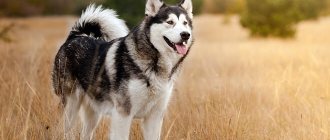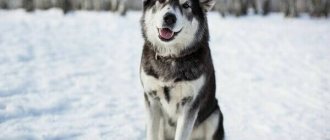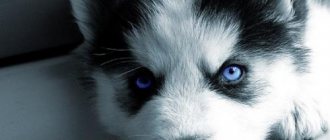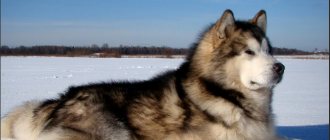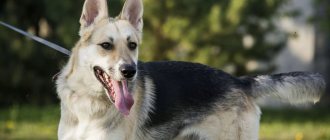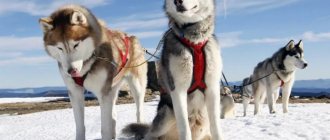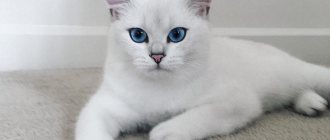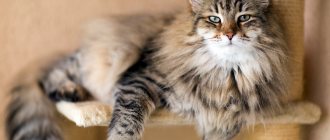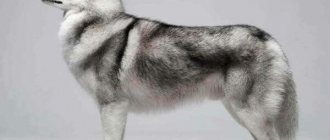External differences
It is not always clear to fanciers how to distinguish a husky from a malamute. At first glance, the dogs look the same.
However, there are significant differences in appearance.
First of all, the Malamute is distinguished from the Husky by its large size and heavy bones. The dog reaches 64 cm at the withers and weighs up to 38 kg. Siberians are smaller - 54 cm and 28 kg. A visual comparison allows you to immediately notice that Alaskans are much more massive.
Siberians are thin, graceful and graceful. When properly maintained, they have well-developed muscles that do not weigh down the body one bit and do not gain excess weight.
Beginners confuse not only Siberians and Alaskans, but also do not understand how the Laika differs from them. These are different animals. The latter are hunting dogs, not sled dogs.
What is the difference between an Alaskan Malamute and a Siberian Husky?
| Characteristic | Malamute | Husky |
| Head | Voluminous, massive, with wide cheekbones and powerful jaws. However, it does not cause disharmony with the general appearance. | Neat, medium size, with a pronounced stop. The muzzle is dry and narrow. |
| Eyes | Obliquely set, almond-shaped, brown. Dogs with blue irises are disqualified. | Almond-shaped, slightly slanting. The difference between a Malamute and a Husky that immediately catches your eye is the color of the iris: brown, blue or multi-colored. |
| Ears | Triangular, erect, widely spaced. The tips are noticeably rounded. They look straight, but when working the animal often puts them back. | Triangular, erect, fleshy, set high and close. Directed straight up. |
| Nose | Black. Animals that are red in color are brown. Light colored lobe is not acceptable. | Black, with liver coloring brown. White dogs are allowed flesh color. Pink stripes (“winter nose”) are acceptable. |
| Breast | Powerful, well developed. | Deep, but not wide. |
| Frame | Compact, athletic. Elongated in a ratio of 9 to 10 (height at the withers/length). | The bone structure is medium, not coarse, without weaknesses in structure. |
| Tail | Medium set. When at rest, it is raised above the back, but does not curl into a tight ring. When in motion it develops like a plume. | Looks like a fox. When alert, it rises above the back and takes the shape of a sickle. At rest it hangs down. |
| Paws | With wide pads that prevent you from falling into the snow. Rough to the touch. | Oval, compact, medium size. |
Huskies and Malamutes have a double coat with a soft undercoat that protects them from cold and moisture. But Alaskans have coarser and stiffer guard hairs. It's impossible to tell from the photo what the difference is between them. To do this, you need to touch the fur of both animals.
The colors of Husky and Malamute are also different:
- Siberians - all colors from black to white. There are unique markings or patterns on the head;
- Alaskans have a raincoat type of coloring. White is dominant in the lower torso. The main color can be any shade of gray, black, sable, red. Only one solid color is allowed - white.
Malamutes and Huskies move differently. The first ones run smoothly, balanced and productive - maximum efficiency with a minimum of effort. These are peculiar “tractors” of the dog world. The latter are more flexible, fast and light. They have a wide reach in the front legs and a strong drive in the hind legs. The photo clearly shows the difference between the two animals.
Some “specialists” at poultry markets are trying to convince buyers that huskies and huskies are the same thing. You don't need to trust such experts.
Northern sled breeds
As noted above, this breed is considered one of the oldest in North America. The teachings state that it is Malamutes who live most with the company of people.
We invite you to familiarize yourself with: Cat exhibition “Russian Cup - Super Ring” - Moscow
The DNA of Alaskan Malamutes is close to that of the wolf. Such data became known after special research.
It is also believed that these dogs came to North America along with nomadic tribes that came from the eastern region of Siberia approximately 14 thousand years ago.
It is worth noting that the DNA is similar between the following breeds: Alaskan Malamute, Siberian Husky, Alaskan Klee Kai. With the help of photographs of the Alaskan Malamute, you can clearly evaluate how this breed differs from others similar to it.
Alaskan Malamutes are large and strong dogs. They have great endurance and strength. Their maximum height at the withers reaches 64 centimeters, and their weight reaches 34 kilograms. Such parameters are typical for male dogs.
The maximum height of the bitches is 58 centimeters, weight – 34 kilograms. However, as an exception, smaller and larger individuals are found.
Size is not as important when assessing a dog as its proportionality, agility and activity.
Representatives of this breed have a large head, proportional to the size of the body. If you look at the muzzle from the front, its shape should visually resemble that of a wolf. The eye shape is almond-shaped, the size is medium. Normal eye color is brown.
The ears are triangular in shape with rounded tips. They are spaced widely on the head.
Alaskan Malamutes have a thick, double coat. This “fur coat” allows dogs to feel great even in the harshest winter.
During the summer, dogs shed heavily and their coat becomes thinner. This breed has several colors: gray, black and white.
Another breed that belongs to the northern sled dogs is the Samoyed (Samoyed dog). And despite the fact that all three of these breeds belong to the same group, their purposes are still different.
Huskies were used to transport small loads, but the Malamute was a heavyweight dog that transported impressive loads over long distances. Samoyeds were helpers of shepherds, defended houses from wolves, and sometimes carried small luggage.
Hence the differences in the character of these breeds. Husky is the most independent dog of the three, and Malamute always strives for leadership, which is why it is much more difficult to raise him. But the Samoyed is a wonderful companion dog that can also be an excellent nanny for children.
Husky, Malamute, Samoyed are the most popular, but far from the only breeds related to northern sled dogs. There are about ten of them in total - this is not counting the aboriginal breeds that are not recognized by the International Canine Federation. All these dogs are united by physical endurance, unpretentiousness, a strong constitution and a calm, balanced character. Northern sled dogs were used to transport people or goods on sleds over snow or ice.
All sled breeds are different, but what they have in common is that they all help a person survive in the most difficult conditions of the far north, becoming not only an indispensable assistant, but also a faithful, loving friend.
Character
Malamutes and Huskies have different temperaments. The former are more balanced, never lose self-esteem, but are more prone to stubbornness. The latter are cunning, resourceful and curious.
Siberians have very lively facial expressions - they frown, show interest, surprise, and joy. Alaskans always have a good-natured “facial expression.”
Huskies and Malamutes resemble children - friendly, cheerful, mischievous. Siberians are very playful. If they lack attention, they often do mischief - they damage things and furniture or dig huge holes. If the animal has not been attacked, it may escape, despite the owner’s protests. It is no coincidence that there are now so many advertisements about “lost dogs” of this particular breed.
Disqualifying faults for malamutes and huskies are a tendency to aggression or cowardice.
Siberian Husky and Alaskan Malamute love active games. When raising pets, experienced dog breeders alternate mental and physical exercises. Animals need a leader with a strong character who will gain their respect. But you should never use violence - the dogs will be offended and stop respecting the person.
With proper upbringing, both breeds do not show unmotivated aggression towards people and get along well with children. Some of them are bad watchmen and security guards. Small pets often exhibit a hunting instinct. What distinguishes a Malamute from a Husky is their attitude towards their own kind. The Alaskan is more dominant, so fights for leadership arise between dogs.
Breeding goals
Huskies and Malamutes, photos of which are presented in the article, are sled dogs that can run tirelessly along a snowy road. But they were bred for different purposes. In terms of performance characteristics, the differences between the Malamute and the Husky are quite significant.
The homeland of Malamutes is Alaska. They are capable of carrying heavy loads. Animals are not so fast, but very hardy and strong. The second breed appeared in the northeastern part of Siberia, and was registered in the USA in the 30s of the 20th century. She is agile and playful, but the carrying capacity of dogs is much lower.
This implies a difference in appearance. To give a brief description, Alaskans are marathon runners, Siberians are sprinters.
Another popular sled breed is the Samoyed. But this dog is completely white, so there is usually no confusion.
Features of maintenance and care
Malamutes and huskies are energetic and require long walks and active games. A house with a spacious garden area where they can move freely is best suited for keeping. It is more difficult to keep pets in an apartment.
Unlike huskies who bark loudly, malamutes prefer to remain silent or grumble quietly.
Standard care for both dogs:
- mandatory hygiene procedures;
- periodic combing;
- bathing.
Alaskans should be limited in their diet - dogs are prone to overeating. Siberians are much more restrained in this regard.
Huskies and Alaskan Malamutes are distinguished by good health. But sometimes they suffer from diseases of the eyes, skin and musculoskeletal system.
History of origin and purpose
Husky is a northern breed, one of the oldest, whose DNA is most similar to the wolf. This is a sled dog, bred to run in a harness and carry loads, and can withstand severe frosts. She is one of the fastest and most resilient dog breeds. True, now they are used more for competitions than for a method of human movement.
The Malamute is also a northern sled dog. It must be said that in appearance they are more similar to large wolves, but at the same time they are very affectionate and good-natured. If the husky can be called graceful without a twinge of conscience, then the Alaskan malamute is a rather massive dog in its structure, which allows the breed to carry heavier loads. Dogs are good in harness, but have a developed desire for leadership, their trust must be won.
Who to choose: husky or malamute
When deciding who to choose – a husky or a malamute – you need to consider 3 important points:
- Both breeds are not suitable for beginners. Dogs need a strong leader who can curb their temperament and overcome stubbornness;
- It is difficult to keep animals in an apartment. They need to move a lot;
- a pet will not grow into a bodyguard or watchman. Malamutes and huskies are friendly towards strangers and do not perceive them as a source of danger.
Active people who want to have the same energetic companion are better suited to the Siberian. Calm and balanced - Alaskan. The former prefer to live in a group, the latter - alone. If a resident of an apartment is thinking about a sled dog, he should choose a husky. Their fur is odorless and shedding is much easier. In addition, they are easier to educate.
The difference between a husky and a malamute is clearly visible in the photographs, especially if the dogs are standing next to each other. It is impossible to say for sure who is better. The choice of breed depends more on personal preferences and the character of the future owner.
History of the origin of breeds and the purpose of dogs
To begin with, it is worth considering the origin of such a breed as the Siberian Husky. These dogs were bred by the Chukchi in Siberia. They were of great importance to this people. Dog sleds were a means of transportation; warm clothes were made from their wool; they helped people keep warm. Later, after Alaska was sold to the United States, these dogs were found there too.
Blue-eyed Husky is a very active dog
For your information! In the 19th century The sport of sled dog racing gained popularity. The Husky breed was perfect for him. Thus, these dogs have become very common throughout the world, and especially in the northern regions.
Malamute and Husky are similar in origin and purpose. The Alaskan Malamute is one of the oldest breeds that appeared several centuries ago in Alaska. These dogs take their name from the Malmut tribe, which lived in Alaska and developed this breed. Dogs were intended for transport purposes, to keep people warm, and in addition, they were excellent and very intelligent companions for people.
Note! In the 18th century During the gold rush, malamutes became widespread because there was no other way of transportation. After the popularization of sled dog racing, the breed spread throughout the world, just like the husky.
Malamutes can stay in the snow for hours without freezing
How are they similar?
Firstly, Huskies and Malamutes are very similar in the purpose for which they were bred. Secondly, you can find external similarities by comparing these dogs. Color, body structure, muzzle shape - these are the signs by which it may seem that the breeds are similar. But if you take a closer look, it turns out that they are very different.
